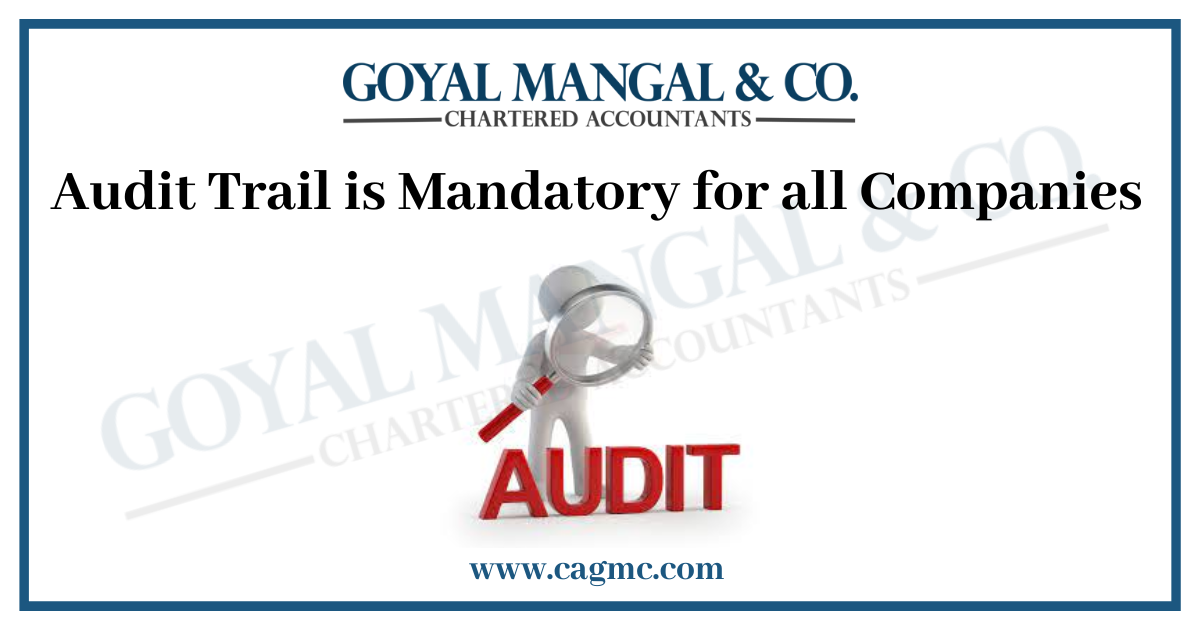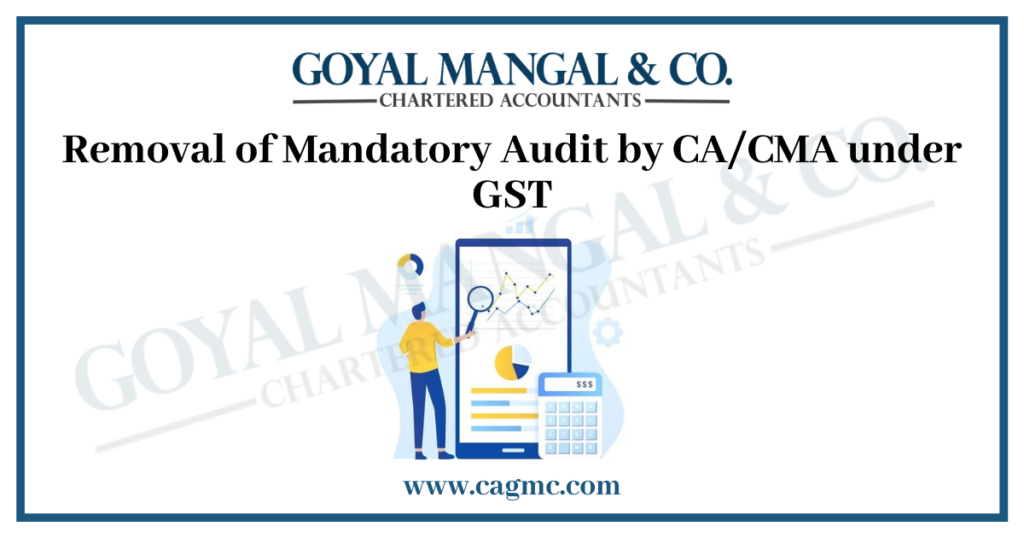
An audit trail is a record of all events and transactions that occur within a system, network, or application. It is a chronological record of every digital activity, user interaction, and system function.
An audit trail helps to ensure the integrity and accuracy of data by providing a detailed history of every action taken on it. This can be useful in a variety of contexts, such as financial transactions, legal proceedings, or compliance with regulations.
With effect from 1st April 2023 all companies big or small, including not-for-profit companies licensed under Section 8 of the Indian Companies Act ,must ensure that the software which they use has a built-in mechanism to record audit trail. In this article we will have an understanding about Audit Trail is Mandatory for all Companies.
|
TABLE OF CONTENTS |
Quick Look
This brief article discusses the mandatory necessity for all businesses (large and small) to record transactions in software with an audit trail capability. The obligation also applies to auditors of such companies, who must include information about the presence of such audit trails in their reports to company shareholders.
An audit trail is a detailed record of events or procedures that provides support documentation and tracks and traces financial data or other business transactions. It is used to authenticate security and operational actions, mitigate challenges, or provide proof of compliance and operational integrity. An audit trail is important for all companies because it helps verify and validate financial, software, and business transactions, and is often a regulatory requirement in many financial areas.
It is a best practice for a thorough and organized accounting department. Maintaining an audit trail can help with data security, governance, and access, and can prevent wrongdoing or malicious actions with sensitive business data.
Purpose or Importance of Audit Trail.
Businesses must establish a comprehensive and full audit trail to follow back any abnormalities and identify process failures when they occur. An airtight audit trail assists businesses in detecting internal fraud by tracking different users and the actions they do with reference to a company’s data and information.
Outside data breach issues can also be identified using audit trail information. Malware and ransomware crimes are on the rise and keeping an audit trail can help discover and highlight instances when outsiders are attempting to cause harm while simultaneously also strengthening your organisation’s information security capabilities.
If those arguments aren’t convincing enough, keep in mind that audit trails are necessary for companies to be in compliance with The Companies (Accounts) Rules, 2014 & Companies (Audit and Auditors) Rules, 2014.
Amendment related to Audit Trial.
The Companies (Account) Rules 2014 has been amended. This new rule requires that every company that use accounting software for maintaining books of accounts shall use such accounting software which has:
The feature of recording an audit trail of each transaction.
- Establishing an edit log of each modification made in books of accounts.
- The date when such change was made.
- Ensuring that the audit trail cannot be disabled.
Also, the amended rule requires that for maintaining its books of account the companies must use accounting software that has below mentioned features:
- The recording audit trail (edit log) facility was used throughout the year for all transactions recorded in the software.
- The audit trail feature was not tampered.
- The audit trail was retained by the company in accordance with statutory record retention requirements.
In addition to these obligations, rules also require that businesses keep an audit trail of their actions. The audit trail must include the following data.
- Every transaction that occurs within the company is documented, including the date, amount, and nature of the transaction.
- Every modification made to the books of accounts, including the date and nature of the change, must be documented.
- All authorizations for transactions and changes to the books of accounts, must be documented, including the names of those who authorised them.
- All approvals and rejections of transactions and changes to the books of accounts, must be recorded, including the names of those who approved or rejected.
- Details of all access to the books of accounts, including the date and time of access, and the name of the person who accessed them.
- Details of all backup and restoration activities related to the books of accounts.
The audit trail must be kept for at least eight years after the end of the financial year to which it relates. Regulators can readily follow the history of any individual transaction and identify inconsistencies by keeping an audit trail. This can aid in the prevention of financial irregularities and ensuring that the organisation follows all applicable rules and regulations.
Amendment Related to Audit trail that need clarification.
The rules are silent on the following points:
- The Rules do not specify which fields or data sets must keep audit trails, whether transactional data or data relevant to the transaction.
- The term accounting software is not specified in the act/rules. Will it contain fixed asset registers, HR-related documents and data/software, employee time sheets, purchase orders, modifications to vendor master data, or any other programme that has an interface with the basic accounting software? If it does, then an audit trail for any connected software must also be checked.
- Accounts regulations mandate daily backups; does this imply that audit trail backups must also be taken on a regular basis? This would necessitate a significant amount of IT space, for which businesses would need to plan of time.
- The accounting standards require that businesses use accounting software that includes an audit trail capability. If a firm is unable to obtain such software or has obtained it in the middle, will it be considered as non-compliance with the Companies Act, 2013, for which the company, its directors, and its KMP may be penalised.
How to Do an Audit Trail: What Should Be Included?
An audit trail should include the information needed to establish what events occurred and what person or system caused them. That event record would then specify when it happened, the user ID associated with it, the program or command that initiated the event, and the result. All these items are date and time stamped.
The information is then collected chronologically by the trail. If an audit trail incorporates keystroke monitoring, it indicates that the keys a computer user activated as well as the computer response throughout the session are recorded.
Keystroke monitoring can include email and other, more extensive viewing of characters as they are typed by users during a session. Keystroke monitoring is often used in intensely secure areas to avoid external access.
It should be noted that audit logging can have privacy consequences, and users should be aware of any applicable privacy laws and policies. At its core, how to conduct an audit trail contains all activities and instructions started by each user, the files and resources accessed, and the date and time of these operations.
More insight about Audit Trail and Audit Requirement
The implementation of Audit trail will lead to lot of benefits but at the same time it will be quite challenging too. Let’s have a look on other insight about Audit Trail and about Audit Requirements:
- No other nation in the world has such a strict mandate on the upkeep of books of accounts and the evaluation of audit trails by company auditors.
- For small businesses that cannot afford such software, or even if they can, the cost of managing books of accounts in such a software will provide a barrier in terms of cost and obtaining the appropriate manpower.
- Previously, only major organisations’ IT systems were subject to scrutiny by auditors, but with the advent of audit trails and reporting based on them, auditors will now be required to audit the IT environment of all businesses. This will lengthen the audit process and increase the cost of the audit for the company.
- Auditors may have some time to catch up since this kind of audit will only be required starting on April 1, 2024, when they should be prepared (in terms of IT knowledge and related resources).
- Before March 31, 2023, all organisations must contact their auditors, present them with a plan of action to comply with the Rules, and discuss with them how they will approach reporting on this specific clause in the audit report. This will guarantee that the auditee and the auditor start off on the same page.
Challenges in Audit Trail
The challenges associated with maintaining an audit trail can include:
- The location used for storage, their size, overall access, and storage timelines.
- Logs can become difficult to navigate when they increase in size, which may bring with it storage cost issue.
- If access is too broad amongst team members, data security can be compromised.
- Collecting too much information in the audit trail can lead to storage capacity issues.
Conclusion
In conclusion, an audit trail is a detailed, chronological record that tracks and traces financial data or other business transactions. It is an essential tool for ensuring data integrity, compliance, and security, and is often a regulatory requirement in many financial areas.
Maintaining an audit trail can help businesses detect unauthorized use, errors, and fraud, and improve internal controls. It can also help businesses have better control over what is happening inside the company and deter internal fraud.
However, there are challenges associated with maintaining an audit trail, such as the cost of implementation, the complexity of the software, and the need for employee training. Despite these challenges, audit trails are like an insurance policy, and when you need their information, you really need it.


